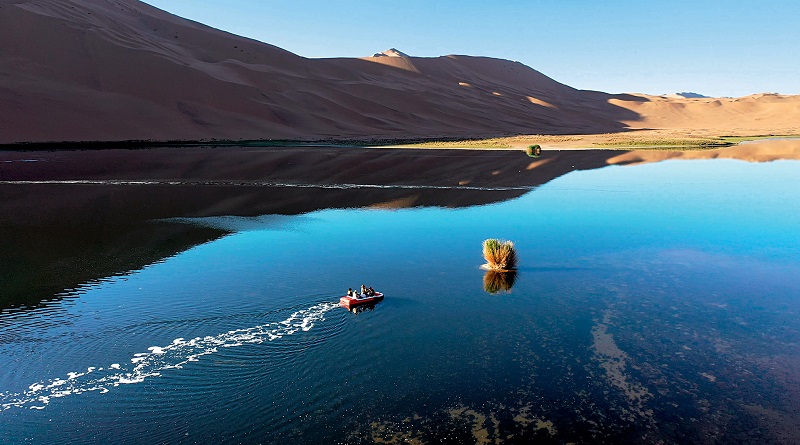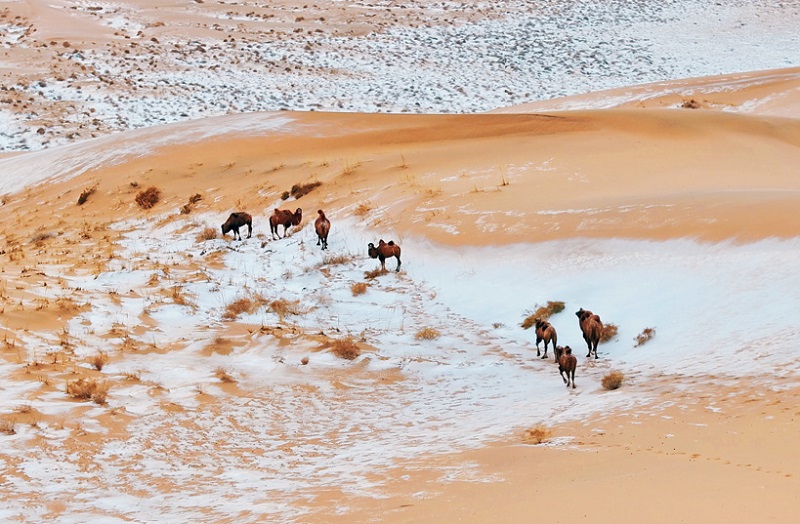It took seven years to win recognition for the Badain Jaran Desert as a UNESCO World Heritage Site, reflecting China's dedication to natural heritage protection and the international community's recognition of its value.
When American journalist Donovan Webster explored the Badain Jaran Desert, the fourth largest desert in the world lying in Inner Mongolia Autonomous Region in northern China, he was struck by its history dating back to the 14th century. He was also impressed by the hospitality of the locals wherever he went, offering him accommodation, food, and travel tips.
He and many other explorers and geologists would be happy that the unique desert of sand towers and lakes has been recognized as a UNESCO World Heritage Site, the first such honor for a Chinese desert. With this inclusion, China now boasts 15 World Natural Heritage sites and four heritage sites noted for both cultural and natural features.
Local legends say Badain was the name of a Mongolian shepherd who came to the desert, discovered its freshwater lakes, and settled down among them. Some media reports say the desert gets its name from its lakes, meaning “mysterious lakes” in the Mongolian language. The desert has an amazing abundance of lakes, a whopping 144, 12 of which are freshwater ones. The Yinderitu Lake is a special one as it has both saline and drinkable sweet water. This remarkable source of water nurtures vegetation, including fruit trees.

A stunning view of a lake in the middle of the Badain Jaran Desert. He Yan
The “sand towers” are towering sand dunes, the highest stationary dunes in the world which can reach over 500 meters in height. The sand dunes also “sing,” giving rise to another name for the desert: the place of singing sands. The songs are the hums, whistling sounds and booms caused by electrostatic change due to friction among sand particles as they are driven by the wind. However, despite the variety of flora and fauna, the ecosystem here is extremely fragile.
More than 50 herdsman families live in this isolated desert, and they do their best to protect the ecosystem. Families are asked not to dig more than two wells to conserve the groundwater and they do not litter. Nonbiodegradable objects like glass bottles are taken to the nearest town for recycling.
These days, as tourists come to the desert to explore this off-the-beaten-track destination, some of the local families have started running homestays. Li Jingyuan is one of them. He opened a homestay in 2018. It has solar panels to generate clean energy, wastewater treatment facilities and a mobile network. “Whenever we go to town for groceries, we take our trash like bottles and cans,” he told the media. A popular tourist experience is to explore the desert on camelback. Stargazing at night, when the sky is clear and the wind fresh, is another prime attraction.
Wang Bin, who also runs a homestay, is proud that the desert is now on the UNESCO World Heritage List. “The beautiful scenery and good ecological environment here attract tourists,” he said. “Everyone here is responsible for protecting the animals and the environment.”
A nature reserve was established here in 1999 to preserve the landscape and the local plant and animal species.
“Its inclusion to the World Heritage List is a result of the efforts of countless people,” said Liang Baorong, director of the Alxa Right Banner Bureau of the Alxa Desert UNESCO Global Geopark. The application process was difficult and long, spanning seven years.
Chinese and foreign experts inspected the desert in 2017 and 2018 and concluded that it met the conditions for application. The nomination was made in 2017 and two years later, Badain Jaran was included in the Tentative List of World Heritage Sites. Finally, the approval came in 2024, at the 46th session of the UNESCO World Heritage Committee in New Delhi, India, on July 26. The entire process reflects China’s dedication to natural heritage protection and the international community’s recognition of its value.
The UNESCO recognition took into consideration the characteristics of the tectonic changes in the region, climate change, its geomorphological evolution, and even hydrogeological changes. Badain Jaran is a world representative area for studying desert development and the formation of the aeolian landform. Due to the continuous tectonic movement in the Qinghai-Tibet Plateau raising the area, the formation of the desert continues. Its size and integrity are important to understand its ongoing evolution and research is conducted regularly to record the changes.

The Badain Jaran Desert covered by a layer of snow. Zhang Leyuan
Li Zhuolun, director of the Center for Glacier and Desert Research at Lanzhou University in northwest China, goes to the desert annually to conduct research and field surveys. “Desert areas are very sensitive to global climate response, and the study is a key area for geoscience research,” Li said.
In his opinion, the most important thing in desert ecology protection is to use water resources rationally. Badain Jaran has perennial lakes, whose color changes according to the season. In July 2024, faculty and students from 18 Chinese universities, including those in Hong Kong, conducted field investigations on the geomorphology, soil, vegetation, climate, and hydrology of the desert.
“The successful UNESCO application means a new starting point,” said Yao Xiaode, director of the Forestry, Grassland and Desertification Control Bureau of Alxa Right Banner. Yao said the banner will improve the protection and management of natural heritage sites, strengthen the monitoring and scientific research of the dunes, lakes and vegetation, and establish and improve site monitoring systems and databases.
The local people are encouraged to be involved in the conservation, co-management, and monitoring of the desert as well as public education. The aim is to achieve a balance between the protection of natural heritage and sustainable social and economic development through eco-tourism.
The desert is attracting foreign tourists. Jin Ga Seon, a South Korean tour guide who has been in the profession for 20 years, said he has brought tourist groups about 10 times.
“Driving through this terrain is not for the faint-hearted nor is there any room for indecision,” warned Runan and Henning Dohrmann Zhang, co-founders of Awwt, a fair-trade art platform, who came here. However, once you go there, the spiritual benefits are immense.
Alxa Right Banner will conscientiously fulfill the Convention Concerning the Protection of the World Cultural and Natural Heritage, and assume the responsibility to protect the outstanding universal value of this heritage site and its authenticity and integrity from destruction. The banner will further improve the protection and management level of this natural heritage site, strengthen the monitoring and scientific research of natural values and elements such as sand dunes, lakes and vegetation, and implement adaptive management. The banner will also establish and improve site monitoring systems and databases, and carry out targeted conservation and governance measures. 
LIU HONGZHANG is a journalist at Inner Mongolia Daily.
WANG XIAOCHUN is a journalist at Alxa Right Banner Digital Media Center.